#mongolia attractions
Explore tagged Tumblr posts
Text
Начинаем день с разминкой от манула. We start the day with a warm-up from the Pallas' cat.
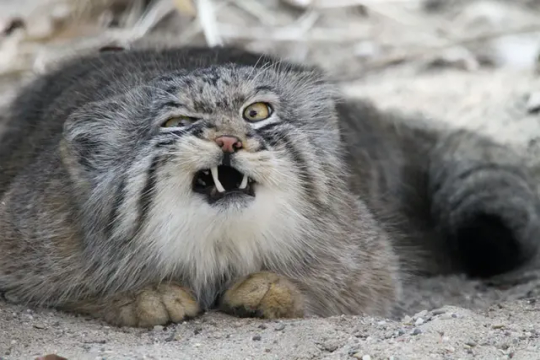
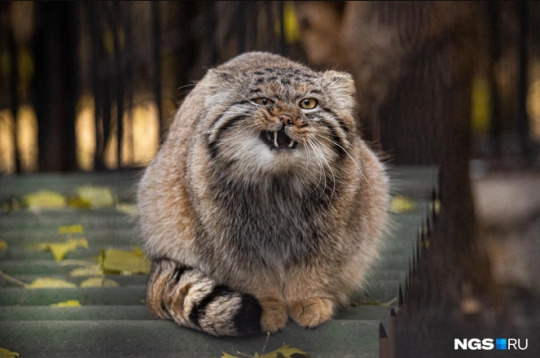
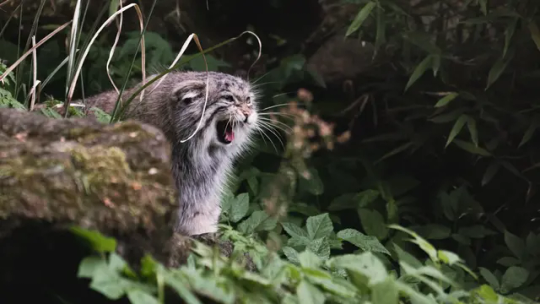
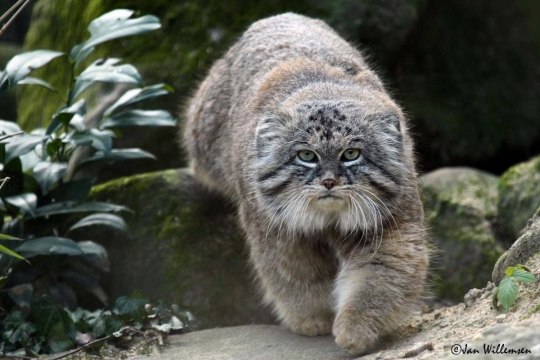
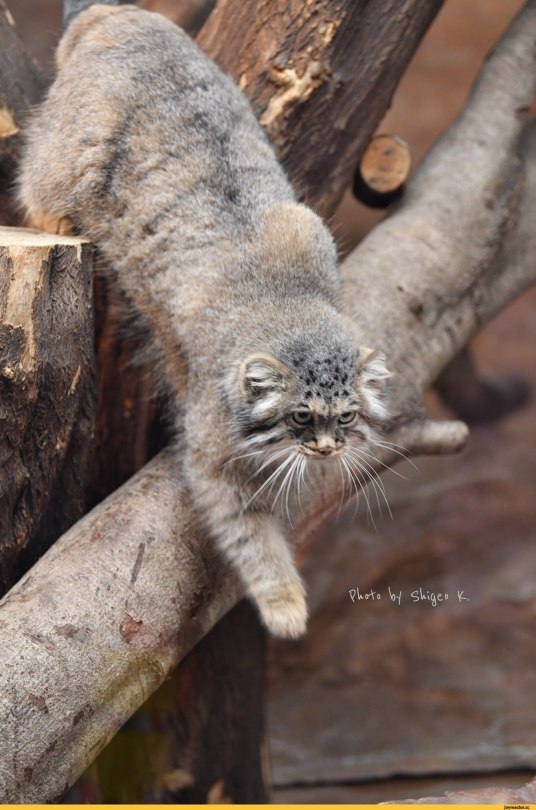

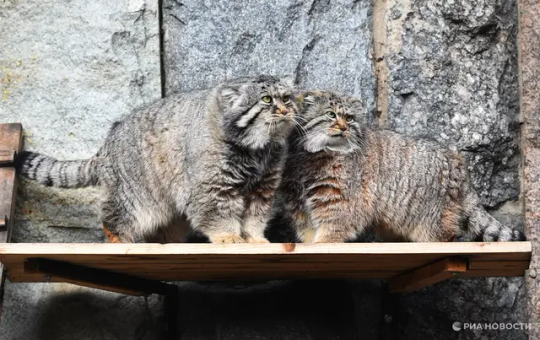
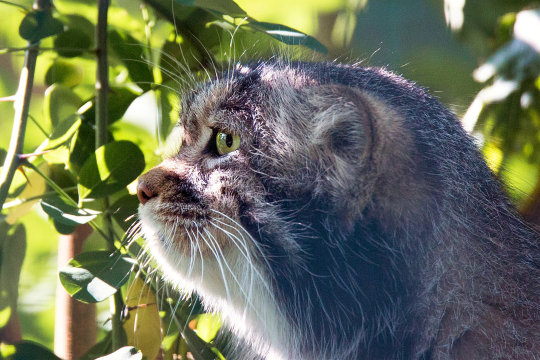
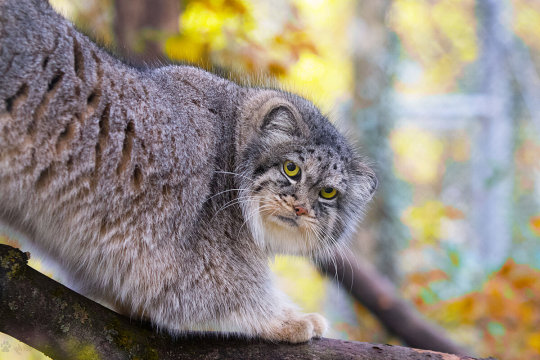

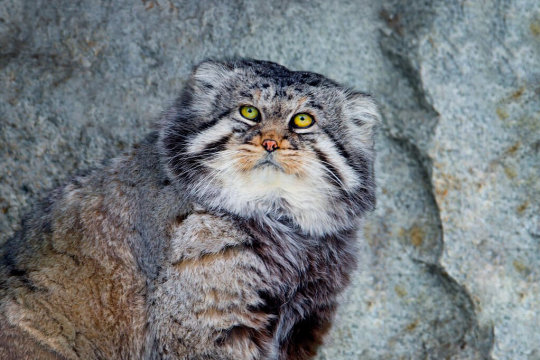


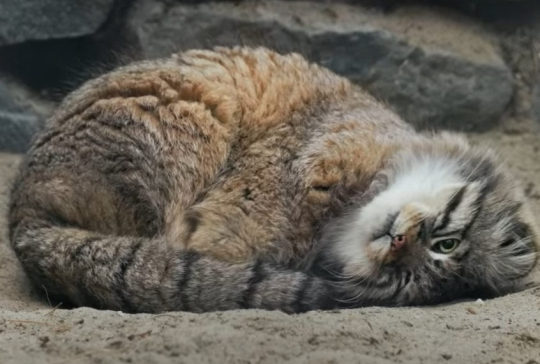
Манул (или палласов кот) — это небольшой дикий кот, обитающий в центральной и северной Азии. Он является исчезающим видом и включен в Красную книгу России и других стран. Считается, что манулы одни из старейших диких кошек. Манул довольно мелкий для диких кошачьих — размером с домашнюю кошку. Длина тела достигает 50-62 см, хвост — 23-31 см, вес — от 2,5 до 4 кг, хотя из-за пышного меха манул выглядит довольно крупным и тяжелым. У манулов самый густой мех среди всех представителей семейства кошачьих: на один квадратный сантиметр туловища у них приходится до 10 тысяч шерстинок. Именно поэтому манулы спокойно относятся к холоду: им комфортно гулять и охотиться при температуре до минус 50 градусов. Ареал обитания манула очень широк. Манул обыкновенный преимущественно обитает в России: в Сибири, Красноярском крае, Забайкалье, Туве и на Алтае. Его также можно встретить в Монголии и Китае. Среднеазиатский манул водится в Афганистане, Узбекистане, Пакистане, Туркмении, Таджикистане, Иране и Казахстане, а тибетский — на Тибете, в Кашмире и в Непале.
Манул один из самых интровертных представителей семейства кошачьих. В дикой природе они ведут обособленный образ жизни, стремятся к одиночеству и не любят контактировать с какими-либо живыми существами, включая своих же собратьев: при встрече с ними они дерутся не на жизнь, а на смерть. Манулы — животные тихие и крайне редко издают какие-либо звуки, дабы не привлекать лишнего внимания. Но если дикий кот и подает голос, то это меньше всего похоже на мяуканье кошки: манулы шипят, кряхтят и рычат. Одна из самых характерных черт манулов — их огромная тяга к свободе.
The Pallas cat is a small wild cat native to central and northern Asia. It is an endangered species and is included in the Red Book of Russia and other countries. Pallas' cats are believed to be one of the oldest wild cats. Manul is quite small for a wild cat - the size of a domestic cat. Body length reaches 50-62 cm, tail - 23-31 cm, weight - from 2.5 to 4 kg, although due to the lush fur, the Pallas's cat looks quite large and heavy.Pallas' cats have the thickest fur of any member of the cat family: they have up to 10 thousand hairs per square centimeter of their body. This is why Pallas’ cats are calm about the cold: they are comfortable walking and hunting at temperatures down to minus 50 degrees. The habitat of the Pallas's cat is very wide. The common manul lives mainly in Russia: in Siberia, the Krasnoyarsk Territory, Transbaikalia, Tuva and Altai. It can also be found in Mongolia and China. The Central Asian Pallas's cat is found in Afghanistan, Uzbekistan, Pakistan, Turkmenistan, Tajikistan, Iran and Kazakhstan, and the Tibetan Pallas's cat is found in Tibet, Kashmir and Nepal.
Manul is one of the most introverted representatives of the cat family. In the wild, they lead an isolated lifestyle, strive for solitude and do not like to contact any living creatures, including their own fellow creatures: when meeting them, they fight to the death. Pallas' cats are quiet animals and rarely make any sounds, so as not to attract unnecessary attention. But if a wild cat makes a voice, it is least like a cat’s meow: Pallas’ cat hisses, grunts and growls. One of the most characteristic features of Pallas cats is their great desire for freedom.
Источник:/pets.mail.ru/stories/10-neozhidannyih-faktov-o-manulah-kotoryie-vyi-mog/,https://www.techinsider.ru/science/1568331-samyy-strannyy-rossiyskiy-kot-vse-fakty-o-manule/, t.me @kotya, //dzen.ru/a/Y0MkRW5adSgkm6rT,/www.ixbt.com/live/offtopic/kto-takie-manuly-i-chem-oni-otlichayutsya-ot-obychnyh-koshek.html.
#video#nature#animal video#animal photography#cute animals#animals video#wild cats#Pallas cat#Manul#видео#природа#фото животных#животные#дикие кошки#палласов кот#Манул#милота
199 notes
·
View notes
Text
this whole lando and donald trump shit is gonna blow over so quickly btw it always does bcos people in the f1 fandom could literally not give less of a fuck about minority/vulnerable groups. nothing happened when carlos sainz made racist comments about chinese people eating dogs in 2020. nothing happened when sainz sr took photos of his dinner the leader of the alt right party in spain. nothing happened when max verstappen used the r slur and m slur towards lance on team radio and nothing happened even after mongolia made a complaint to the UN about his conduct and red bull joked about it the next week in one of their pr videos. nothing happened when nelson piquet and his family got outed as close friends and supporters of jair bolsonaro. nothing happened when zak brown bitched about politics in f1 and then filmed a video with a tory minister. nothing happened when a 20 year old ayrton senna dated a fucking 15 yr old girl! nothing!
you cannot convince this fandom to not bat for these white men, no matter what they say or do. they will die on that hill and they will look like some godforsaken amalgamation of a teenaged kpop stan sending death threats and a disney/marvel adult twisting progressive language in defense of blind media consumption.
ultimately and above all, their comfort and attraction will overwhelm anything else. praxis to them is looking at these coddled fucking manbabies and saying "oh he's so gay" "omg trans ally" "feminist king" when he blinks.
there is a massive conversation we could have about the intrinsic classism, racism and fascism that you cannot remove from f1 (and the whole of motorsport!) without crumbling its core foundations. about how every driver on the grid is complicit in these systems and how they overwhelmingly use their wealth to ensure it's existence. it will not happen here because interaction in that fan space has degraded to sending death threats because you have decided to criticize their specific special human incarnation of oatmeal slop
#anti f1#anti formula one#anti verstappen#anti lando#anti sainz#anti Ferrari#anti mclaren#anti senna#Christ is that every tag?#i hope so because every time i forget one i get people calling me a r***** on anon god FUCK this fandom#okay to reblog
118 notes
·
View notes
Text
Moth of the Week
Antler Moth
Cerapteryx graminis
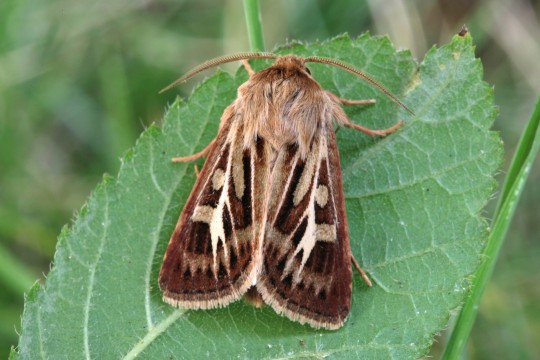
The antler moth is a part of the family Noctuidae. It was first described in 1758 by Carl Linnaeus. This moth gets its name from the antler shaped mark in its forewings.
Description This moth species has brown forewings, with a “basal streak” of white that branches out. This mark may vary in size per moth. The forewings show a mirrored pattern of the base brown broken up by the branches and a few spots and lines of lighter brown. The forewing also may or may not have black streaks. The hindwing is dark brown with a white fringe.
Males are smaller than females with fluffier antennae.
Male Wingspan: 27 - 32mm (≈1.06 - 1.26in)
Female Wingspan: 35 - 39mm (≈1.38 - 1.53in)
Diet and Habitat The larva of this species feeds on grasses such as Deschampsia, Sheep’s-fescue (Festuca ovina), Mat-grass (Nardus stricta) and Purple Moor-grass (Molinia caerulea). It has also been found on sedges and rushes. When the larva population is concentrated enough, they can damage pastures. Adults feed on flowers such as thistles and ragworts.
This species is common through most of Europe. It’s northernmost reach is Iceland and above the Arctic Circle. It’s easternmost reach is Siberia and North Mongolia. This moth does not occur in the dry southern regions of Europe. It has been introduced to North America. Additionally, this species inhabits the Alps. They prefer habitats of grassland, favouring acid upland pasture, moorland and downland.
Mating Adult moths are seen flying from July to September. They presumably mate in this time frame.
Predators This moth flies during the day, especially in the north, warm weather, and early mornings, and at night. They are presumably preyed on by both daytime and night time predators like birds and bats. They are attracted to light. To protect themselves during the day, this moth hides in the grass.
Fun Fact The antler moth rises to an altitude of 2100 meters in the Alps.
(Source: Wikipedia, Butterfly Conservation)
#libraryofmoths#animals#bugs#facts#insects#moth#lepidoptera#mothoftheweek#antler moth#Noctuidae#Cerapteryx graminis
202 notes
·
View notes
Text
Stone Turtle of Karakorum, Mongolia, c. 1235-1260 CE: this statue is one of the only surviving features of Karakorum, which was once the capital city of the Mongol Empire
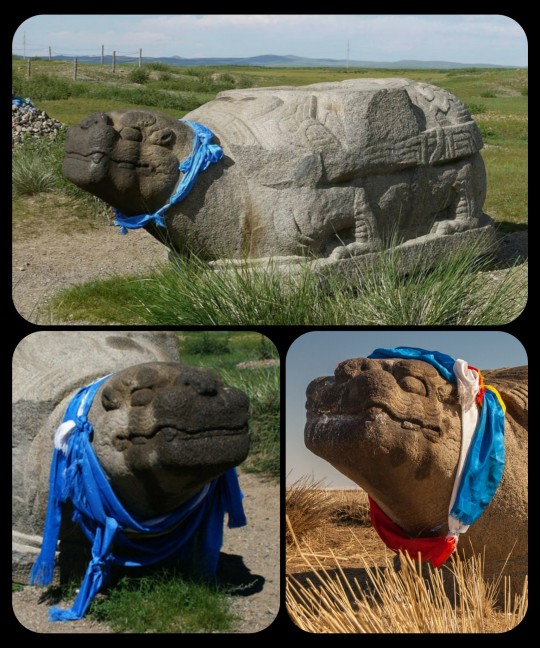
The statue is decorated with a ceremonial scarf known as a khadag (or khata), which is part of a Buddhist custom that is also found in Tibet, Nepal, and Bhutan. The scarves are often left atop shrines and sacred artifacts as a way to express respect and/or reverence. In Mongolia, this tradition also contains elements of Tengrism/shamanism.
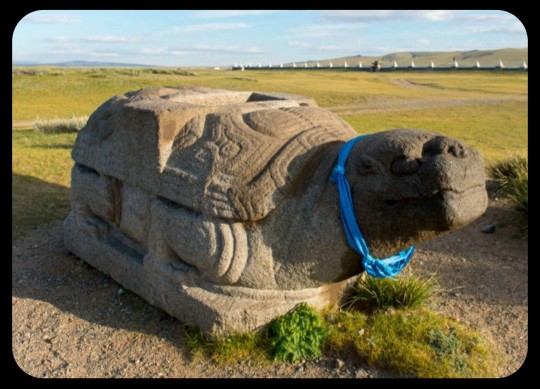
The city of Karakorum was originally established by Genghis Khan in 1220 CE, when it was used as a base for the Mongol invasion of China. It then became the capital of the Mongol Empire in 1235 CE, and quickly developed into a thriving center for trade/cultural exchange between the Eastern and Western worlds.
The city attracted merchants of many different nationalities and faiths, and Medieval sources note that the city displayed an unusual degree of diversity and religious tolerance. It contained 12 different temples devoted to pagan and/or shamanistic traditions, two mosques, one church, and at least one Buddhist temple.
As this article explains:
The city might have been compact, but it was cosmopolitan, with residents including Mongols, Steppe tribes, Han Chinese, Persians, Armenians, and captives from Europe who included a master goldsmith from Paris named William Buchier, a woman from Metz, one Paquette, and an Englishman known only as Basil. There were, too, scribes and translators from diverse Asian nations to work in the bureaucracy, and official representatives from various foreign courts such as the Sultanates of Rum and India.
This diversity was reflected in the various religions practised there and, in time, the construction of many fine stone buildings by followers of Taoism, Buddhism, Islam, and Christianity.
The prosperous days of Karakorum were very short-lived, however. The Mongol capital was moved to Xanadu in 1263, and then to Khanbaliq (modern-day Beijing) in 1267, under the leadership of Kublai Khan; Karakorum lost most of its power, authority, and leadership in the process. Without the resources and support that it had previously received from the leaders of the Mongol Empire, the city was left in a very vulnerable position. The residents of Karakorum began leaving the site in large numbers, until the city had eventually become almost entirely abandoned.
There were a few scattered attempts to revive the city in the years that followed, but any hope of restoring Karakorum to its former glory was then finally shattered in 1380, when the entire city was razed to the ground by Ming Dynasty troops.
The Erdene Zuu Monastery was later built near the site where Karakorum once stood, and pieces of the ruins were taken to be used as building materials during the construction of the monastery. The Erdene Zuu Monastery is also believed to be the oldest surviving Buddhist monastery in Mongolia.
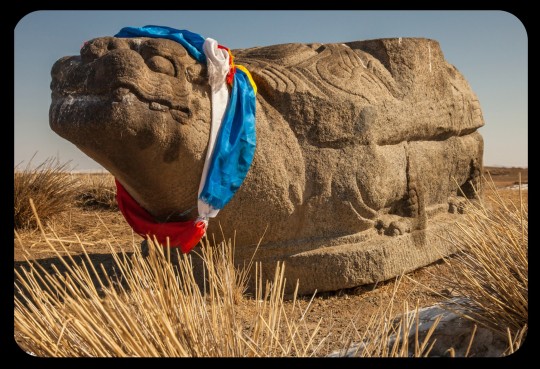
There is very little left of the ruined city today, and this statue is one of the few remaining features that can still be seen at the site. It originally formed the base of an inscribed stele, but the pillar section was somehow lost/destroyed, leaving nothing but the base (which may be a depiction of the mythological dragon-turtle, Bixi, from Chinese mythology).
This statue and the site in general always kinda remind me of the Ozymandias poem (the version by Horace Smith, not the one by Percy Bysshe Shelley):
In Egypt's sandy silence, all alone,
stands a gigantic leg
which far off throws the only shadow
that the desert knows.
"I am great OZYMANDIAS," saith the stone,
"the King of Kings; this mighty city shows
the wonders of my hand."
The city's gone —
naught but the leg remaining
to disclose the site
of this forgotten Babylon.
We wonder —
and some Hunter may express wonder like ours,
when thro' the wilderness where London stood,
holding the wolf in chace,
he meets some fragment huge
and stops to guess
what powerful but unrecorded race
once dwelt in that annihilated place
Sources & More Info:
University of Washington: Karakorum, Capital of the Mongol Empire
Encyclopedia Britannica: Entry for Karakorum
World History: Karakorum
#archaeology#history#anthropology#artifact#ancient history#mongol empire#mongolia#karakorum#middle ages#ancient ruins#art#turtle#bixi#ozymandias#poetry#mythology#genghis khan
248 notes
·
View notes
Text

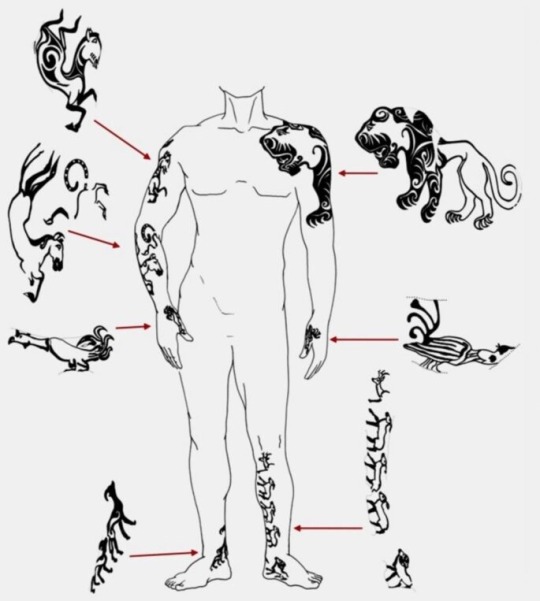

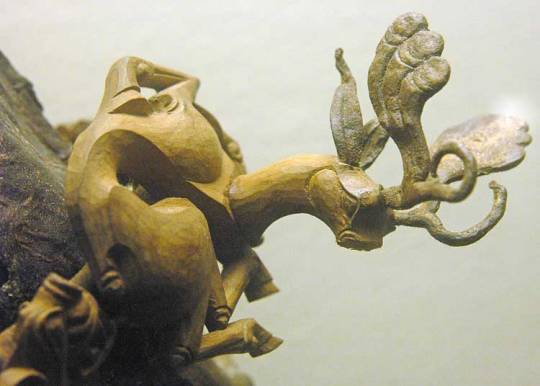


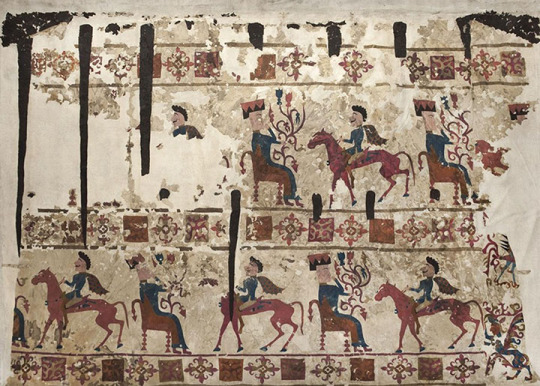



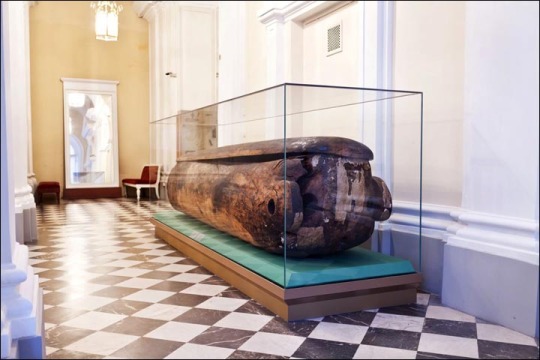






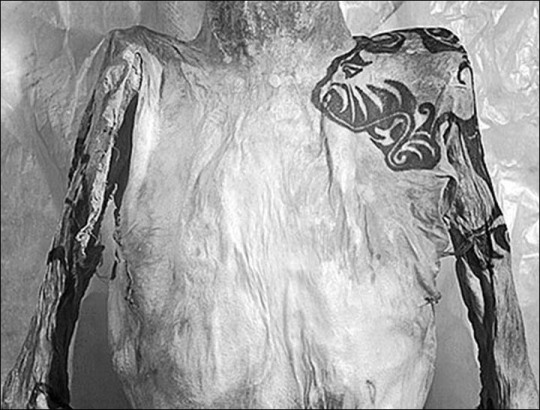
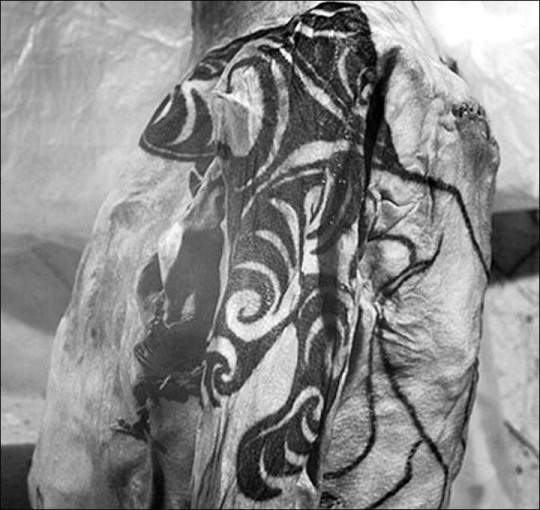



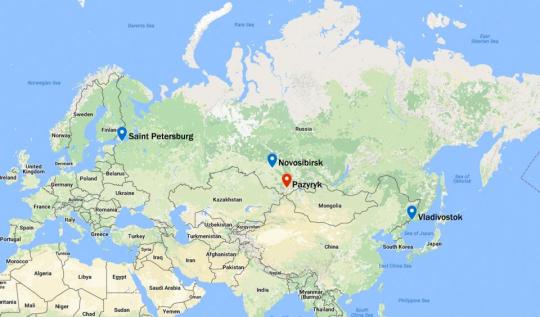

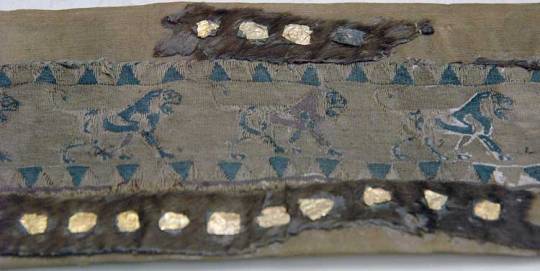
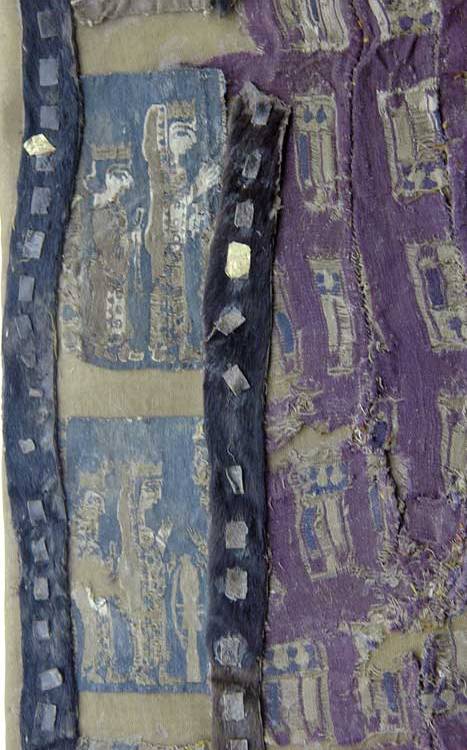



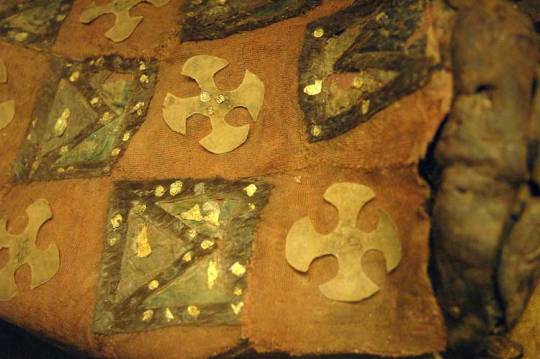
Scythian mummy tomb (Fifth Pazyryk Kurgan), Pazyryk culture 3rd C. BCE. More pictures on my blog, link at bottom.
"The pair were buried alongside nine horses, a huge cache of cannabis and a stash of priceless treasures - including the world's oldest carpet and an ornate carriage.
The man had curly hair and was aged between 55 and 60 when he died, whilst the woman was about ten years younger.
It is believed he was a chieftain or king of the Pazyryk civilisation, which lived in Kazakhstan, Siberia and Mongolia from the 6th to 3rd centuries BC."
...
"The attractive log cabin was a prefabricated construction by the prehistoric Pazyryk culture to house an elite tomb - in which was buried a mummified curly-haired potentate and his younger wife or concubine.
The mound in the Altai Mountains was originally 42 metres in diameter, and this tattooed couple went to the next life alongside nine geldings, saddled and harnessed.
The house itself, recently reconstructed, was not built as a dwelling but nevertheless is seen by archeologists as showing the style of domestic architecture more than two millennia ago.
This structure was the outer of two wooden houses in the large burial mound in the valley of the River Bolshoy Ulagan at an altitude of around 1,600 metres above sea level.
The core of the mound including the ice-preserved bodies of the elite couple had been excavated by Soviet archeologists in 1949, and many of the finds are on on display in the world famous State Hermitage Museum in St Petersburg.
As we have previously written, the pair - who owned perhaps the world’s oldest carpets - are currently undergoing an ultra modern medical scan to establish the cause of death, and reconstruct the appearance of the ancient pair, and to study the techniques of mummification in more detail.
Yet in 1949 this fascinating house was left in the permafrost ground - and only retrieved now from the so-called Fifth Pazyryk Barrow, to the excitement of archeologists.
Head of the excavation Dr Nikita Konstantinov from Gorno-Altaisk State University, was full of admiration about the skills of the ancient craftsmen.
‘We took out the log house and reassembled it right next to the mound,’ he said.
‘We made kind of express reconstruction, which made it possible to study the log house in detail.
‘Notches were made on each of its logs - building marks…’.
This was like IKEA instructions today for building their products, telling modern day excavation volunteers how to correctly construct the prehistoric building kit.
The result is seen in the pictures shown here.
‘This log house was first built somewhere away from the mound, then it was dismantled, brought and reassembled in the pit,’ said Dr Konstantinov.
‘Today we build in similar way, using Roman numerals, as a rule.
‘In those times they simply made different numbers of notches.’
The archeological team followed the code left by the ancient craftsmen and reassembled the house without problems.
‘The Pazyryks knitted the corners of the building in a masterly way and chopped the attachment points of these logs.
‘They fitted very cleanly….
‘When we built the log house and began to measure the height, it turned out that the height difference in the angles is only one centimetre.’
In modern constructions, a difference of 7 cm is allowed which showed how skilful were the ancient craftsmen.
He said: ‘This is a funerary structure, but we can say with a high degree of probability that the log cabin was created in the image and likeness of the houses in which the Pazyryks lived."
-taken from siberiantimes and thesun
#scythian#pazyryk#saka#pagan#archaeology#anthropology#architecture#history#ancient history#museums#mummies#artifacts#antiquities#ancient art#tattoos#4th century bce
416 notes
·
View notes
Text

Originally thought to be a species of “Ingenia” (now known as Heyuannia), Khaan mckennai was eventually determined to be unique enough for its own genus. While a small, relatively inconspicuous ovoraptorid, its name is derived from the Mongol word for “lord” or “ruler”. In an environment full of larger oviraptorids and dromaeosaurs, I’m not sure Khaan would have felt much like a ruler in its day! Like other oviraptorosaurs, it was probably a herbivore or omnivore, and it had a very strong bite force built for feeding on much tougher vegetation than what other herbivores could eat. In a desert environment, dinosaurs would have needed whatever nutrition they could get, and it was helpful to have special adaptations like this. Perhaps, then, Khaan was the king of crunching on cycads.

The holotype of Khaan is a relatively complete skeleton found together with another similarly sized Khaan. These two, having been buried by a collapsing sand dune and fossilized together, are informally referred to as “Romeo and Juliet.” Further investigation shows that this couple did indeed show signs of sexual dimorphism. While they were relatively similar in size, Romeo had a muscular, more flexible tail, signifying that male Khaans may have shook their tail fans to attract a mate. Meanwhile, the shorter spines on Juliet’s tail vertebrae may have given her more room for laying eggs.

Found in the Ukhaa Tolgod locality of the Djadochta Formation of Late Cretaceous Mongolia, Khaan would have lived alongside some familiar dinosaurs. These include fellow oviraptorid Citipati, the dromaeosaurs Tsaagan, Velociraptor mongoliensis, and Halszkaraptor, the troodontids Byronosaurus and Almas, alvarezsaurids like Kol and Shuvuuia, birds like Apsaravis and Gobipteryx, ankylosaurs like Minotaurasaurus and Pinacosaurus grangeri, an indeterminate protoceratopsid, as well as lizards, turtles, and small mammals.


This art may be used for educational purposes, with credit, but please contact me first for permission before using my art. I would like to know where and how it is being used. If you don’t have something to add that was not already addressed in this caption, please do not repost this art. Thank you!
#Khaan mckennai#Khaan#oviraptorid#oviraptorosaurs#theropods#saurischians#dinosaurs#archosaurs#archosauromorphs#reptiles#SaritaDrawsPalaeo#Djadochta Formation#Mongolia#Late Cretaceous
12 notes
·
View notes
Text

#Archovember Day 27 - Udanoceratops tschizhovi
The leptoceratopsids are known for being small, pig-sized Late Cretaceous ceratopsians reminiscent of their more basal ancestors. But Udanoceratops tschizhovi took things to the next level, growing to the size of a hippopotamus, with the head and jaw strength to match. While assumed to be a herbivore like other ceratopsians, little is known about plants that grew in the Gobi Desert at the time of the Cretaceous, so it is unclear what types of plants it would have eaten. Its sharp beak, powerful jaws, and shearing/crushing teeth suggest a diet of relatively tough plants. Like other ceratopsians, particularly leptoceratopsians, Udanoceratops could have also opportunistically scavenged carcasses, nests, or even small mammals and young/weak dinosaurs for extra protein in its desert environment.

In the Djadochta Formation of Mongolia, Udanoceratops would have lived alongside the smaller, more numerous protoceratopsians Protoceratops and Bagaceratops. This was a mostly barren landscape, likely dotted by oases and arroyos that would have attracted smaller animals like nanhsiungchelyid land turtles, lizards like Gobiderma, frogs like Gobiates, crocodylomorphs like Artzosuchus, small mammals like Asiatherium and Mangasbaatar, and small theropods like the oviraptorosaur Avimimus. Udanoceratops was the largest animal around. Thus far, no predators large enough to take on an adult Udanoceratops have been found in its locality. The dromaeosaur Velociraptor could have snatched a baby Udanoceratops when the opportunity arose, but it would then risk the ire of this giant desert hippo with a staple remover for a head.
#my art#SaritaDrawsPalaeo#Udanoceratops tschizhovi#Udanoceratops#Leptoceratopsid#neoceratopsians#ceratopsians#ornithischians#dinosaurs#archosaurs#archosauromorphs#reptiles#Archovember#Archovember2023
31 notes
·
View notes
Text
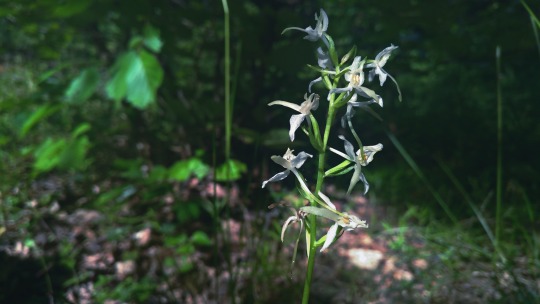

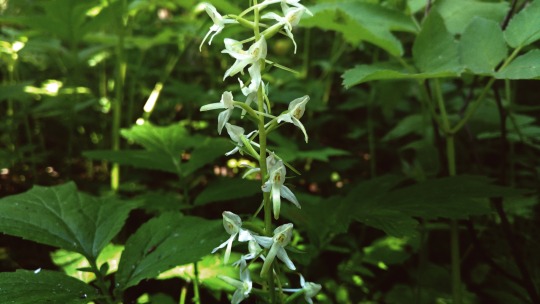
Любка двулистная (Platanthera bifolia)
Любка – орхидея северных лесов. На стройном стебле этой орхидеи возвышается длинная изысканная кисть белоснежных цветков, удивительно напоминающая бабочек. Ее изящные цветки словно сделаны из фарфора — настолько плотные и сочные их лепестки.У основания стебель охвачен широкими черенками двух крупных, супротивно расположенных блестящих листьев эллиптической формы. Это наша родная орхидея — Любка, некогда широко распространённая в Европе, на Кавказе, в Малой Азии, Сибири, Монголии, а сейчас занесённая в Красные книги различных регионов и полностью исчезнувшая вблизи крупных городов.
Русское название растения связано с тем, что когда-то клубни любки считали приворотным зельем. В некоторых странах это растение называют орхидеей-бабочкой. Известно также немало других народных названий растения: ночная фиалка, дикий бальзам, кукушкины слёзки, любовный корень, ночные духи, перелой, стагачка.Опыляют цветки большие ночные бабочки, которых привлекает аромат, усиливающийся вечером.
Lyubka bifolia (Platanthera bifolia)
Lyubka is an orchid of the northern forests. On the slender stem of this orchid rises a long, exquisite brush of snow-white flowers, surprisingly reminiscent of butterflies. Graceful flowers come from porcelain - their petals are extremely dense and juicy. This is our native orchid - Lyubka, once widely known in Europe, the Caucasus, Asia Minor, Siberia, Mongolia, and is currently listed in the Red Books of various regions and has completely disappeared in the nearby areas of cities.
The Russian name of the plant is due to the fact that once the tubers of Lyubka were considered a love potion. In some countries, this plant is called a butterfly orchid. Many other popular names for the plant are also known: night violet, wild balsam, cuckoo's tears, love root, night perfumes, staghachka. The flowers are pollinated by large night butterflies, which are attracted by the aroma, which intensifies in the evening.
#россия#русский tumblr#природа#лето#национальныйпарктаганай#таганай#урал#природнаякрасота#орхидея#цветы россии#макрофото#мои фото#russia#summer#nature#nature photography#ural#Taganay#russiantravel#travel#wildflowers#orchid#flowers aesthetic#my photos#original photography#beauty of nature#flower photography#macro photography#photographers on tumblr
58 notes
·
View notes
Text
Hunted to extinction in the wild in the 1960s, today there are nearly 1,000 Przewalski’s horses at three sites in Mongolia, with more in China and Kazakhstan. The biggest population – numbering 423 – is in central Mongolia’s Hustai national park, the descendants of 84 animals airlifted from European zoos in the 1990s.
Each year they attract tens of thousands of visitors to this small patch of pristine mountain steppe just 100km from the capital, Ulaanbaatar.
“Before the reintroduction, nobody believed we could save this species,” says Dashpurev, who runs Hustai national park. Since then, the International Union for Conservation of Nature (IUCN) has downgraded the risk status of Przewalski’s horse twice: “Our biggest achievement,” he says.
The success stands in stark contrast to other parts of Mongolia. Over the past three decades, the country’s wildlife has been decimated by a combination of hunting, the climate crisis and overgrazing, with creeping desertification turning huge tracts of its vast grasslands into dust.
“Mongolia’s wildlife is in crisis,” says Tungaa Ulambayar, the local representative of the Zoological Society of London. “It is in real danger of being wiped out.”
27 notes
·
View notes
Text
Diaboys (+Yui) Ideal Vacation destination •3•
•Yui grew up so sheltered, she barley saw anything in Japan X-X. So I think she should visit Mt. Fuji first, you know, get to know see the main attraction of her country. She definitely has dreams to travel the world tho.
•Shu does NOT travel. Too much effort. But if he did I think somewhere very secluded. I really like the Idea of him in Greenland, but it might bring back some traumatic memories… (the girls that get it, get it). So maybe and Icelandic Island, or somewhere in the Scottish highlands (can someone please draw Shu chilling with Nessie X-X).
•Reiji is fluid in German so I think he should visit the alps, but the Austrian ones. With all due respect I don’t think my man can handle north Germany X-X (as a German who’s das lives in north Germany, but grew up in the south. I know). I also have a headcanon, that Reiji is very good at skiing. Not sure if he can understand Austrian alp dialect (my grandmas from there so again. I know) but I believe in him
•Ayato would probably be somewhere warme. To do all the water sports and stuff. I really like the Idea of him in Mexico
•Kanato CAN’T go anywhere too warm or sunny. I think Switzerland, the mother of chocolate (let’s not talk about where chocolate is ACTUALLY from). Swiss chocolate just hits different
•Laito goes to Greece. It’s just right.
•Subaru is also not a travel man, but I like him in either the Netherlands or New Zealand. I can’t explain it just feels right
•Ruki would probably go somewhere in the Caucasus area, like turkey or Armenia (yes I know turkey isn’t actually Caucasus area, but I forgot the English word for it). Like I totally think he would explore the remains of Troy (if it really was troy) and go to archeological sights. I also like the idea of him in west Africa for the same reason.
•Yuma would go to a small village in Calabria (I hope that’s also what it’s called in English, but anyways it’s in south Italy). He would have his own little garden there and gets along great with the locals, despite not speaking a word of Italien.
•Kou has traveled the world, since yk he’s famous. So I think he’d go on a wellness retreat on a mountain in Nepal, or to live with yaks in Mongolia.
•Azusa would either go to the middle of the Saharan desert or to Siberia. No in between. I like him more in Siberia tho. Fun fact: my fathers from a little city in the very VERY west of Siberia, and I’d just think it’s cute if he went there :3 (I’ve literally never been there, even tho I’d really like to go. I just know my dad was born there)
•The Tsukinamis travel together. No other option. If it were up to Carla (which it mostly is) they take a tour around Europe. If it were up to Shin, they’d go somewhere tropical, and very much not Europe, like maybe Kongo or somewhere in South America.
•Kino goes to Korea. Again I can’t explain it, it just makes sense. I won’t specify which Korea… because he would just go to both
#ayato sakamaki#diabolik lovers#dialovers#rejet#sakamaki brothers#yuma mukami#mukami brothers#carla tsukinami#kou mukami#reiji sakamaki
46 notes
·
View notes
Text
Mistakes I Made When Self-Pubbing My First Book (Part 2: Presentation Edition)

"Don't judge a book by its cover" is utter bullshit because that is the #1 thing people do when purchasing a book.
This is the typical process someone will take when clicking on a book listing (though not everyone will do it in this order):
Look at the cover
Read the blurb
Check the reviews
Read a sample
Decide to download
Personally, I check the reviews before I look at the blurb if the cover has caught my attention, but I know many other people read the blurb first.
So you need to have these things locked down. I, being an idiot, did not have these things locked down before I decided to publish 9 Years Yearning. Let us examine my failures.
Making my own shitty cover instead of paying an artist
Now, a caveat.
A lot of self-pubbed writers are excellent graphic designers and really take the time to make a beautiful cover before they publish.
I'm not talking about these supernaturally blessed individuals who can do both. They have my utmost respect.
I'm talking about me, a person who has no design skills and can't draw for shit.
Here is the progression of my book cover.



The first one was made by me using an Unsplash stock photo on Canva. It's boring.
We can tell it's taking place in some rural area (Mongolia-ish, given that this is a photo of Mongolia), but what the hell else do we know about it? We don't see the characters or anything. It very much looks like your typical self-pub cover that the writer spent five minutes on. Shoddy and unprofessional.
The second one was purchased on Fiverr for like $50. It's cute, to be sure, and I'm not knocking the artist because they did exactly what they promised they would do. But it still doesn't tell us much about the story itself. Would do better for like a worldbuilding grimoire or something because it doesn't give us many details.
And now the third one is, in my opinion, absolutely gorgeous, and I will fight anyone who says otherwise. It captures the mood of the setting, shows the characters, and demonstrates that this is a fantasy novel through the fonts and character design.
The artist is Katarina on Fiverr, who will be doing the rest of my series as well. She truly understood the assignment and I am incredibly grateful to her. Katarina is also LOVELY to work with, so if you have a fantasy novel in the pipeline, you should really consider working with her.
My book sales took off significantly after I introduced the third cover. Not phenomenal, of course (why is not Katarina's fault), but definitely way better than before.
I could have gotten more sales if I had presented a good cover during the first 30 days of publishing, when Amazon gives new releases a little boost to help them along. Because I designed a shitty cover, I lost all of that extra marketing power. People were seeing my book, but they weren't clicking because they assumed self-pub = terrible. (Rightly so. A lot of self-pubbed books are terrible.)
But really, I was just a cheapskate. I figured I could just make my own cover and people would magically be attracted to it somehow, which was dumb of me. So I wasted a lot of time when I could have been making sales. I wasn't taking marketing seriously.
So, my tips to other self-pub writers:
If you're not capable of designing your own great cover, then work with an artist. Make sure the artist works in your specific genre, because there are different rules for each genre. Get comp images of other book covers you like to show the artist, or make a mockup (I'll show you one in a second). Very dark covers don't tend to sell well, especially ones in blues and greens. Even if you have a dark romance, try to lighten it up a bit. Fonts are incredibly important because they "prime" the reader to guess what kind of mood the story has. Don't clutter up the cover. Have two focus points, the most important text, and that's it.
For my second book, Pride Before a Fall, I provided Katarina with an incredibly shitty mockup of what I wanted (again, I am not an artist), as well as a ZIP file of the character, their clothing, the horse colorations, and so on.
This made it go much much faster because we weren't constantly messaging back and forth for edits. I only needed her to tweak two things: the clothes Orrinir was wearing and Erix's coloration (Horse 2 in the mockup).


Katrina put some of her own artistic vision into it, of course, but the spirit of what I was trying to show was absolutely there. I vastly prefer her version.
I'll be doing this with the third book as well, which has a slightly different vibe. I have the image in my head, and I just need to figure out how to put it on the page so she can make it better!
Writing a ~mysterious~ blurb
When I first published 9 Years Yearning, I had the same blurb for it as I have on the splash page for The Eirenic Verses:
Uileac Korviridi, student at the Bremish War Academy, expects to focus on his studies and protect his little sister - not fall in love with Orrinir Relickim, the hotheaded infantryman who can't seem to leave him alone.
Which is fine for a list of all the different books in the ten-part series. It is now included in the series list in the back matter for the second book, too.
But it doesn't really tell readers much about what they can expect from the book except that there's a boy, his little sister, and another guy.
It's too vague, too short, and too confusing. Most people would not click on something like that because they have no clue what to expect.
I also didn't need to include the name of the country; you need to avoid throwing too many fantasy names at readers right away or they start to shut down.
The blurb for 9 Years Yearning went through a lot of changes until its current iteration:
Uileac Korviridi, orphaned at age 11 during a raid on the family farm, cherishes the happy memories of living with his late parents. Fond reminiscences are all he has to comfort him in the stern confines of the War Academy, where young boys are trained to protect their besieged nation from a powerful enemy. Even as he forces enthusiasm for his military studies, he must balance his loyalty to his little sister, Cerie, who is training at the High Poetry Society to become a magical wordsmith. In contrast to Uileac's bucolic past, Orrinir Relickim is a former Future Boy: one given up to the War Academy by neglectful parents before enrolling in training. His life has been typified by invisibility, making him desperate to gain attention from anyone - especially Uileac. The two start as resentful quasi-enemies: Uileac despises Orrinir's success in their studies, while Orrinir resents Uileac's happy childhood and delicate looks. However, as they understand one another better, they cannot resist this pull they don't yet understand. What follows is a tale of teenage longing, with all the awkwardness and miscommunication it entails. Set in a sweeping world with poetry magic, 9 Years Yearning offers a brief glimpse into a beautiful country besieged by its enemies, constricted by a mountain range made with words. With lush descriptions, deep emotion, and lyrical prose, this novella sets the stage for grander conflicts in the 10-part Eirenic Verses series. Dive into a world where poetry makes power, seen through the eyes of two young men preparing for war.
It's probably not perfect, but it does have most of the components of a good blurb:
Quickly explains the main character's backstory, goals, and motivations.
Introduces the love interest and his backstory.
Explains the primary conflict without giving away too much.
Tells us what the vibe of the story is (teenagers growing up and being awkward).
Mentions one of the special things about the setting (High Poetry) but also makes it clear that this is not the primary focus (or it would have been put up front more). Readers can tell that it's going to be a background element that will probably be discussed in further detail later on in the series.
Discusses the themes, settings, and what readers can expect from the prose.
Tells readers that this is the beginning of a series.
Note that I did not include any review quotes. That's kind of controversial, but honestly? I don't pay attention to those when reading a blurb unless I immediately recognize the quoted person's name.
Since I don't have a big name reviewing my novel, I'm not going to include opinions from people no one knows. I also know that people can pay to get those quotes and they're not always genuine; they're cherry-picked.
The blurb is crucial for getting readers who like your cover to spend money on the book. You must show that you're a great writer and provide them details about what they can expect. A highly polished, engaging blurb that is descriptive but not spoilery will intrigue people.
Not making enough graphics and visuals

People like visual advertisements more than they like giant walls of text.
It's why advertisers moved away from things like this ....


To things like this ....


Of course, 1920s magazines were not printed in full color, so they couldn't have the bright vibrant reds of the 2020s ads, but the layout is what is important.
Current advertisements don't have a lot of text because humans are visual creatures. Great book advertisements are the same.


Now, obviously I do not have the budget or star power of these authors and marketing agencies, but that doesn't mean I can't do something what I do have. Which is access to Canva and my book covers.
But I did not do that with my first book. I didn't do any visuals at all. Instead, I just threw the link around everywhere and expected people to click on it. Which is pretty dumb tbh. Of course no one's going to click on a random link that you didn't explain anything about! We've all been Rickrolled at least once!
And then I got no sales and was sad about it and realized I was dumb to do that.
I am fixing that with Pride Before a Fall. I changed all my socials to have a banner for my book, including just a few words.

Excellent, marketing agency quality? No, of course not. But it's something visual anyway. It's clear that I put some thought into it, that I have a professional cover, and I'm pretty clear with what I want you to do: preorder the fucking thing by January 1st.
And again, I'm picking up some preorders already. I expect that as I continue to produce more visuals, I'll get more preorders. And, of course, my upcoming ARC campaign will help too.
I have seen some artists do little videos for their books which look pretty interesting. I will likely do this when I'm a bit further along in the series by working with a visual artist, but I'm not quite there yet. Soon, though.
So that is part two of my series on my failures. Part 3 will go into depth about the importance of reviews and how not to go about getting them.
And if you made it this far, maybe you'll consider buying my book, which is somehow good despite all my failures!

Please do not forget to leave a review! It's essential, as I will explain in Part 3. And I have heard that those who leave reviews for self-pubbed authors are more likely to find a really nice crunchy leaf on their next walk. mmm mcrunnchyy
#self publishing#indie author#indie publishing#self publication#self published#writing a book#book marketing#author#aspiring author#young author#writing community#writers community#writers of tumblr#writeblr#writeblr community#writer#creative writing#writerscommunity#writers on tumblr
4 notes
·
View notes
Text
Sexuality headcanon
As usual I’m listing several characters into one:
Russia is aroace, non-sex repulsed. He’s okay with sex, okay with people asking him into it and also occasionally ask others into it, but he isn’t attracted to others sexually or romantically. Also doesn’t really see people as man or woman or everything in between; that’s not important to him. He will say he is a man because his physical appearance is male but in the end he doesn’t really perceive ‘manliness’ either.
Mongolia is panromantic/pansexual and poly. Dom switch with 70% top (but it also depends). Prefers to have open relationships and having partners with similar tendencies, but can be exclusive if it’s asked of him. Doesn’t like partners who are possessive to detriment but jealousy is a also a sign of desire so he finds it very flattering at times. Not if it they end up micromanaging him though.
Kazakhstan is demisexual/demiromantic, mainly toward women but can develop attraction to anyone as long as he has already formed deep emotional bonds with them. In this case, he has a mind to pursue women because it’s what’s societally expected of him as a dude, but it just so happens that he’s surrounded by mainly men nations that those are the types he develops attraction for, lol. Used to think of himself as aroace (though there wasn’t a word for this back then) but it all changed when he ended up developing feelings he got destructive over (he’s just dramatic).
Uzbekistan is a pan. Also deeply romantic; he falls in love quite easily and had a lot of experience with dating. Also sees sex as inherently a romantic pursue (not the type to have casuals or able to separate sex from romance or love; at the very least, it’s not something he takes lightly).
Turkey is bi and poly with preference for women, partly because he sometimes is conscious about being a man, but he also deeply appreciates demure and fragrant kind of beauty usually found in women. Also he might be poly, but his egoism and vanity make it that he often refuses to be on equal terms with his partners in the emotional sense and he prefers a harem type of relationship where his partners fawn for him instead.
#hetalia#aph mongolia#hws mongolia#aph russia#hws russia#oc kazakhstan#hws kazakhstan#aph kazakhstan#oc uzbekistan#hws uzbekistan#aph uzbekistan#aph turkey#hws turkey#my headcanon
25 notes
·
View notes
Text
Moth of the Week
Peppered Moth
Biston betularia

The peppered moth is a part of the family geometridae. It was first described in 1758 by Charles Linnaeus. This moth gains its name from its speckled coloration, which has been studied as an example of natural selection and population evolution.
Description This species has a short body with narrow forewings. The body and wings are the same white base peppered with black dots and irregular black lines. This speckled pattern may vary with some moths having very few spots and others having so many that they look as if they are black with white spots as opposed to white with black. In rare cases, the black on the wings and body is replaced with gray or brown and in even rarer cases the spots are a combination of brown and black/gray. These spots help the moth camouflage against lichen on trees.
The evolution of this moth had been studied extensively during the last two hundred years, which created the term “industrial melanism.” During the Industrial Revolution, air pollution killed off lichen and covered trees in soot. This caused moths with a black spots on white base (typica) coloration to lose their camouflage and die off due to predators. This caused a spike in population for moths with a darker coloration (carbonaria) because they had the camouflage advantage. Once environmental conditions improved, the lighter colored moths once again became the dominant coloration.
The male’s antennae are bipectinate, meaning it has two rows of rami going down either side of a singular flagellum.
Wingspan Range: 45 - 62 mm (≈1.77 - 2.44 in)
Diet and Habitat The caterpillar of this moth eats many trees, shrubs, and small plants such as Blackthorn (Prunus spinosa), Hawthorn (Crataegus monogyna), Downy (Betula pubescens) and Silver Birch (Betula pendula), limes, sallows, poplars, oaks, Sweet Chestnut (Castanae sativa), Beech (Fagus sylvatica), Bramble (Rubus fruiticosus), Broom (Cytisus scoparius), Black Currant (Ribes nigrum) and Hop (Humulus lupulus).
They have a wide range, being found in China (Heilongjiang, Jilin, Inner Mongolia, Beijing, Hebei, Shanxi, Shandong, Henan, Shaanxi, Ningxia, Gansu, Qinghai, Xinjiang, Fujian, Sichuan, Yunnan, Tibet), Russia, Mongolia, Japan, North Korea, South Korea, Nepal, Kazakhstan, Kyrgyzstan, Turkmenistan, Georgia, Azerbaijan, Armenia, Europe and North America. They prefer habitats of woodland, scrub, hedgerows, parks and gardens.
Mating Depending on its location, this moth can have one or two generations per year. In Great Britain and Ireland, the peppered moth has one generation per year, whilst in south-eastern North America it has two generations per year. They emerge from the pupea in late May to August.
The females attract males with pheromones, which are carried by the wind. Males follow the concentration gradient to find the female. The male guards the female from other males until she lays the eggs. The female lays about 2,000 pale-green ovoid eggs about 1 mm in length into crevices in bark with her ovipositor.
Predators This species is a night-flying moth, making the vulnerable to bats. The males in particular fly every night to search for a female while females fly only the first night.
To protect themselves from birds during the day, this species rests on lichen covered trees to camouflage themselves.
The day time resting positions of this moth have been recorded and studied. This study shows that the peppered moth prefers resting spots that are covered such as below where the trunk and a branch meet, the underside of branches, and leafy twigs.
Additionally, the study found peppered moths with a lighter coloration (typica) blend in better against crustose lichens rather than foliose lichens because birds can see ultraviolet light. The peppered moth reflects UV light while crustose lichens don’t, making them easier to pick out.
Fun Fact The caterpillars of the peppered moth resemble things in both color and size. An experiment published in 2019 done on the caterpillars of the peppered moth showed that the larva (even when blindfolded) could sense the color of the tree they live on and change their body color to match and/or would move to a different twig that was closest in color to their own body.
(Source: Wikipedia, Butterfly Conservation, Max Planck Institute)
#Biston betularia#libraryofmoths#animals#bugs#facts#insects#moth#lepidoptera#mothoftheweek#Geometridae#peppered moth
87 notes
·
View notes
Text
The House of Mirrors (acotar modern au fic)
Illyria
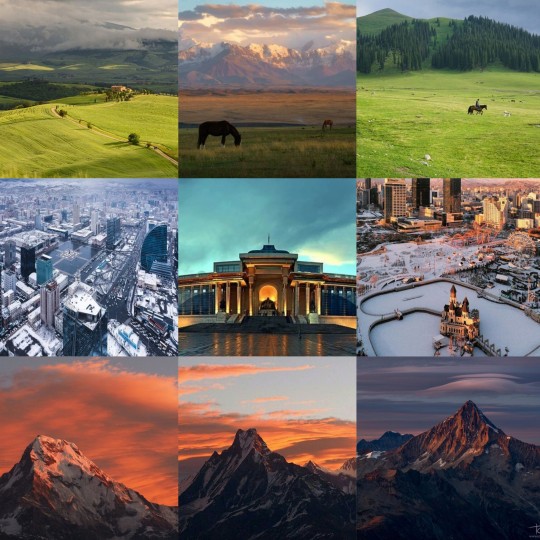
Illyria is a country to the north of Prythian, its capital city is Windhaven.
To the north-west lies the famous Illyrian mountains known for attracting tourists and extreme sports fans.
To the south-east the country smooths out into grassy plains known as the Illyrian Steppes where their famous horses were bred and their historical skills as mounted cavalry were honed.
All Illyrian citizens are required to serve 3 years in mandatory state service. Men often join the military, police, waste and refuse services while women often take on elderly care, administration and the unique, government backed, public animal services which feed and care for the large stray and undomesticated animal population.
It is a well developed country despite most of its land going uninhibited and at least about 67% of Illyrians still live semi-nomadic lives
Key Illyrian characters include
Rhysand
Seren (his sister)
Ayana (his mother)
Cassian (his maternal cousin)
Devlon (Cassian's father)
Azriel (a mercenary with Illyrian prison tattoos; professionally known as the Shadow)
The Illyrian immigrant population in Prythian is the lowest among the Illyrian, Scythian, Bharti and Raskan collectives but lies slightly above the Hybernian's.
*
Irl Illyrians were greek but so were the Scythians so just to differentiate I'm adding stuff based on Mongolia. The city pictures are of Ulaanbaatar, the capital.
21 notes
·
View notes
Text







“Imma Beatcho Butt!”
Roger’s mom says, while giving him the tightest, most loving hug, “Congratulations, baby.” She understands just what it took to get here. Meanwhile, Roger’s next attraction is underway! He heard they just had to try the Mongolia Fried Chicken out in Selvadorada, so he had a private chef bring it in to pair with the meal created for them to enjoy this evening. Someone’s excited!
Previously. (“Ew.”) | Next. (“Thanks, Man.”)
#and conners asking if they know the gender already#ts4#nyrarachelle plays.#ts4 gameplay#black simmer#black simblr#ts4 screenshots#thedysonsistersts4#simblr#sims 4#sims 4 gameplay#ts4 legacy gameplay#ts4 selvadorada#selvadorada
6 notes
·
View notes